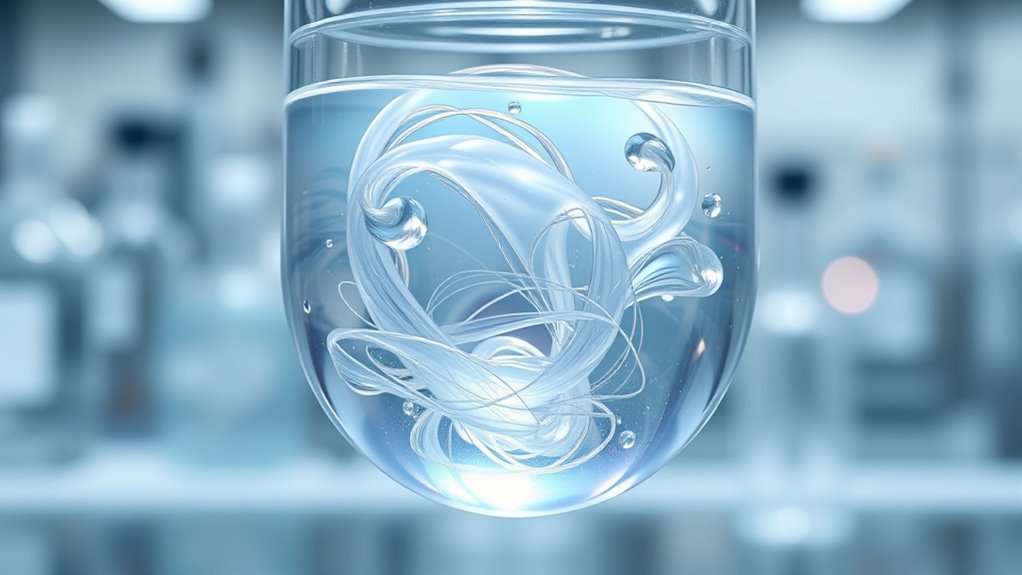Physicists have discovered a remarkable new state of matter that blends properties of solids and liquids. This hybrid phase emerges from complex quantum phenomena, especially quantum superposition, during phase shifts. By controlling temperature and pressure, you can induce this stable state, which exhibits fluid-like behavior with solid-like structure. Its unique characteristics could lead to advanced electronics and new materials. Curious to see how this breakthrough could change science and tech? Keep exploring to find out more.
Key Takeaways
- Physicists have discovered a new hybrid phase that blends properties of solids and liquids through quantum superposition.
- This state emerges during phase transitions, where particles occupy mixed states, enabling a stable, dual behavior.
- The new matter exhibits fluid-like flow while maintaining structural rigidity, defying traditional classifications.
- Control over temperature, pressure, and environment induces this phase, harnessing quantum effects for stability.
- This breakthrough advances material science, opening applications in advanced electronics, superconductors, and adaptive surfaces.

Have you ever wondered what new states of matter scientists can create? Recent breakthroughs have led to the discovery of a fascinating state that blends properties of solids and liquids, opening up exciting possibilities in physics. This new state emerges from complex quantum phenomena, particularly quantum superposition, where particles exist simultaneously in multiple states. Unlike traditional matter, which firmly falls into categories like solid, liquid, or gas, this novel phase exists in a delicate balance, often during phase transitions, when matter changes from one state to another. During these transitions, atoms or molecules can temporarily occupy mixed states, and researchers have harnessed this to generate a new, stable phase with unique characteristics.
In this state, the matter exhibits a fluid-like behavior, flowing and adapting like a liquid, yet maintaining structural rigidity akin to a solid. Think of it as a hybrid that can be manipulated at the quantum level to display properties that seem to contradict classical physics. Scientists have been able to induce this phase by carefully controlling temperature, pressure, and other environmental factors, pushing the material through phase transitions that allow it to settle into this new form. The process relies heavily on understanding quantum superposition, which enables particles to exist in multiple states simultaneously, providing the foundation for this hybrid behavior. When the system is in superposition, the particles aren’t confined to a single phase, but rather, they oscillate between solid-like and liquid-like states, resulting in a stable, new phase that defies traditional classification. This discovery also highlights the significance of phase transitions in creating novel states of matter.
This discovery isn’t just a curiosity; it could revolutionize how we approach material science and technology. For instance, materials in this state might have unique electrical, thermal, or mechanical properties, making them ideal for advanced electronics, superconductors, or adaptive surfaces. Researchers are still exploring how to manipulate and stabilize this phase for practical applications, but the fundamental understanding of phase transitions and quantum superposition is key to unveiling its full potential. By mastering these quantum effects, scientists can design materials that respond dynamically to external stimuli, opening up avenues for innovations we haven’t yet imagined. The ability to create and control such a hybrid state signifies a major step forward in our understanding of matter, merging quantum physics with material science and paving the way for future technological breakthroughs.
Frequently Asked Questions
How Stable Is This New State of Matter Over Time?
You’ll find that this new state of matter is quite stable with regard to material stability, maintaining its unique properties over short periods. However, its temporal longevity is still under investigation, so it may not last long without specific conditions. While initial tests show promising stability, ongoing research is needed to determine how it behaves over extended periods and whether it can be reliably used in practical applications.
Can This State of Matter Exist Naturally Outside Labs?
It’s unlikely this new state of matter exists naturally outside labs, as environmental conditions needed are highly specific. For example, in extreme cold or high pressure, similar phases might form temporarily, but stable, naturally occurring instances are rare. You’d need precise temperature and pressure conditions that rarely align in nature, making spontaneous formation outside controlled experiments improbable. So, this state probably remains a laboratory phenomenon for now.
What Potential Applications Could This New Phase Have?
This new phase could revolutionize material design, giving you innovative options for flexible, durable, and adaptable materials. Its unique phase shift properties allow you to develop smart materials that respond to environmental changes, leading to advancements in electronics, robotics, and medical devices. By harnessing this state, you can create solutions that combine the best qualities of solids and liquids, opening doors to a future of versatile, high-performance materials.
Does This Discovery Impact Our Understanding of Existing Materials?
Yes, this discovery impacts your understanding of material classification and phase changes. It shows that the boundaries between solid and liquid aren’t as clear-cut as once thought, prompting you to reconsider how materials change states. This new phase encourages you to explore how different substances behave under various conditions, potentially revealing novel properties. It broadens your perspective on how matter can exist and transition, enriching your knowledge of physics and material science.
How Difficult Is It to Create and Observe This New State?
You might think creating this new state is a walk in the park, but it’s actually quite challenging. You’ll face experimental challenges like maintaining extreme conditions and precisely controlling variables. Detection techniques become essential, as observing this hybrid state requires sophisticated tools to distinguish its unique properties. So, while it sounds simple, bringing this matter into view demands patience, skill, and advanced technology—making it a tough but exciting scientific feat.
Conclusion
So, congratulations, you’ve just witnessed physicists’ latest trick: blending solid and liquid into a new state of matter. Who knew that breaking the rules of physics could be so delightful? Now, we can all look forward to a future where materials defy expectations, and maybe, just maybe, your morning coffee might someday be a little more solid or a little more liquid—depending on how daring the scientists feel. Cheers to the universe’s endless capacity for surprises!









